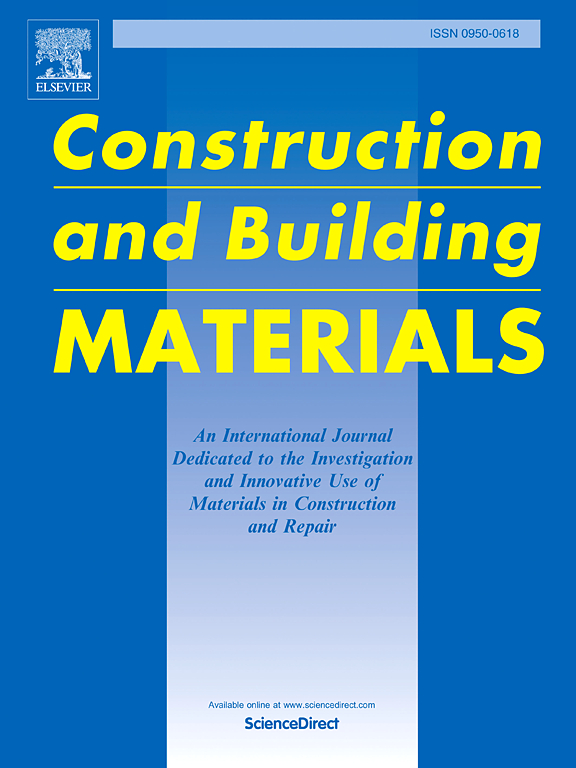Mechanical, microstructural and durable characteristics of foam concrete ceramic mixes exposed to H2SO4 and HCl solution
IF 7.4
1区 工程技术
Q1 CONSTRUCTION & BUILDING TECHNOLOGY
引用次数: 0
Abstract
The soaring quantity of solid garbage resulting from fast population expansion requires immediate sustainable waste management strategies. A viable strategy is to reutilise solid waste products as alternative resources in construction, thereby preserving limited raw materials. The study evaluates the prospects of substituting ceramic waste tile powder (CWTP) partially for cement in foam concrete (FC) to improve environmental sustainability while satisfying essential concrete performance criteria. The study investigates the composition, morphology, and pozzolanic activity of CWTP, together with its impact on the mechanical, microstructural, and durability characteristics of FC. CWTP replaced cement at 10 %, 30 %, 50 %, 70 %, and 90 %, and its effects on compressive, flexural, tensile strengths, porosity, and water absorption were evaluated over time. This study tackles several of significant challenges, including how to integrate waste materials—which frequently degrade performance—while maintaining strength and durability of Foam Concrete. Significant findings indicate that substituting up to 50 % of cement with CWTP yields mechanical qualities that conform to ACI 523 R 2014 criteria, while simultaneously enhancing durability, including improved resistance to sulphates, chlorides, and abrasion. Microstructural study by SEM and XRD validated the advantageous pozzolanic response of CWTP, especially during the later phases of curing. This study presents a new durability index (DI) for evaluating FC mixtures in harsh environments, determining that 50 % CWTP substitution maximises both strength and durability. The results highlight the promise of CWTP as a sustainable substitute for cement, providing environmental advantages and technological viability in foam concrete applications.
暴露于 H2SO4 和 HCl 溶液中的泡沫混凝土陶瓷混合物的力学、微观结构和耐久性特征
由于人口迅速膨胀,固体垃圾数量急剧增加,因此需要立即采取可持续的废物管理策略。一个可行的策略是重新利用固体废品,将其作为建筑中的替代资源,从而保护有限的原材料。本研究评估了在泡沫混凝土(FC)中用废瓷砖粉(CWTP)部分替代水泥的前景,以改善环境可持续性,同时满足混凝土的基本性能标准。该研究调查了 CWTP 的成分、形态和胶凝活性,以及它对泡沫混凝土的机械、微结构和耐久性能的影响。CWTP 取代水泥的比例分别为 10%、30%、50%、70% 和 90%,并评估了随着时间的推移,CWTP 对抗压、抗弯、抗拉强度、孔隙率和吸水性的影响。这项研究解决了几个重大挑战,包括如何在保持泡沫混凝土强度和耐久性的同时,整合经常降低性能的废弃材料。重要研究结果表明,用 CWTP 替代多达 50% 的水泥可获得符合 ACI 523 R 2014 标准的机械质量,同时还能提高耐久性,包括改善抗硫酸盐、氯化物和磨损的能力。通过扫描电镜和 XRD 进行的微观结构研究验证了 CWTP 有利的混凝反应,尤其是在固化的后期阶段。本研究提出了一种新的耐久性指数 (DI),用于评估恶劣环境下的 FC 混合物,确定 50% 的 CWTP 替代品可最大限度地提高强度和耐久性。研究结果凸显了 CWTP 作为水泥可持续替代品的前景,为泡沫混凝土应用提供了环境优势和技术可行性。
本文章由计算机程序翻译,如有差异,请以英文原文为准。
求助全文
约1分钟内获得全文
求助全文
来源期刊

Construction and Building Materials
工程技术-材料科学:综合
CiteScore
13.80
自引率
21.60%
发文量
3632
审稿时长
82 days
期刊介绍:
Construction and Building Materials offers an international platform for sharing innovative and original research and development in the realm of construction and building materials, along with their practical applications in new projects and repair practices. The journal publishes a diverse array of pioneering research and application papers, detailing laboratory investigations and, to a limited extent, numerical analyses or reports on full-scale projects. Multi-part papers are discouraged.
Additionally, Construction and Building Materials features comprehensive case studies and insightful review articles that contribute to new insights in the field. Our focus is on papers related to construction materials, excluding those on structural engineering, geotechnics, and unbound highway layers. Covered materials and technologies encompass cement, concrete reinforcement, bricks and mortars, additives, corrosion technology, ceramics, timber, steel, polymers, glass fibers, recycled materials, bamboo, rammed earth, non-conventional building materials, bituminous materials, and applications in railway materials.
 求助内容:
求助内容: 应助结果提醒方式:
应助结果提醒方式:


